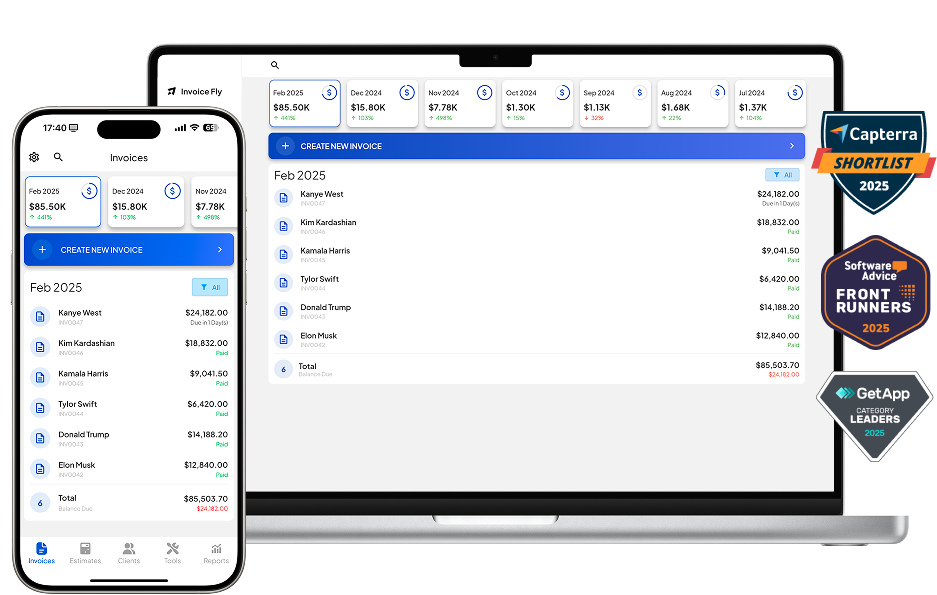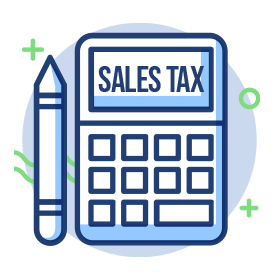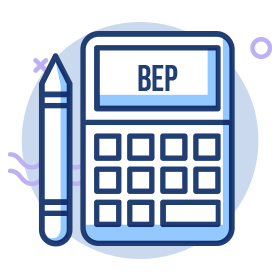- Home
- »
- Free Resources for Small Businesses
- »
- Free Business Calculators
- »
- VAT Calculator
Free VAT Calculator
Use our free Value-Added Tax Calculator to add or remove any VAT from your estimates or invoices before sending it to your customers. Select allocate or charge VAT, enter your amount, tax rate, and let Invoice Fly do the calculations.
VAT Calculator
Region
Country / State
Amount

Total Summary
What is VAT?
VAT (Value-Added Tax) is a consumption tax applied at each stage of the production and distribution of goods and services. Unlike a sales tax collected only at the final point of sale, VAT is charged every time value is added—from raw materials to the end consumer. It’s widely used across Europe, the UK, and many countries worldwide. Businesses collect VAT from customers and remit it to the government, making them responsible for accurate VAT calculations, reporting, and compliance.
How does Invoice Fly's online VAT calculator work?
Our VAT calculator is a free, easy-to-use tool that helps individuals and businesses calculate VAT quickly and accurately. Whether you’re adding VAT to a price or extracting VAT from an inclusive amount, the calculator simplifies the math in just seconds.
To use it, enter your amount, select whether it includes VAT or not, and choose the applicable VAT rate (20%). The calculator will instantly show you the net amount, VAT amount, and total gross price. This is ideal for freelancers, small business owners, contractors, blue collar pros, and accountants who want fast, reliable VAT calculations without manual formulas or spreadsheets.
Real-life example on how to charge or allocate VAT:
How to calculate VAT
Calculating VAT depends on whether you are charging VAT to a net price or allocating VAT from a gross price. Both methods require a clear understanding of your VAT rate and whether your price includes tax.
Allocating VAT
To allocate VAT from a total (VAT-inclusive) amount, you divide the gross price by 1 + the VAT rate (as a decimal). For example, if your gross price is €120 and the VAT rate is 20%, the VAT portion is calculated as:
VAT = €120 – (€120 / 1.20) = €20
This method is useful when you need to separate VAT from a total invoice amount that already includes tax.

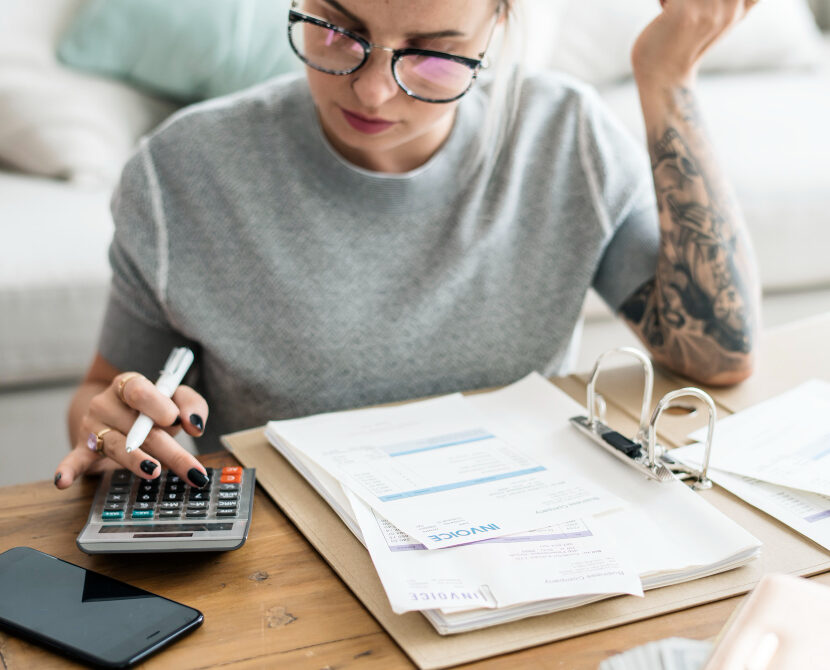
Charging VAT
To charge VAT on top of a base price, you multiply the net price by the VAT rate and add it to the original amount. For instance, with a €100 product and a 20% VAT rate:
VAT = €100 × 0.20 = €20
Total = €100 + €20 = €120
Invoice Fly handles both charging and allocating VAT seamlessly so you don’t have to remember formulas or convert percentages.
Example of allocating VAT
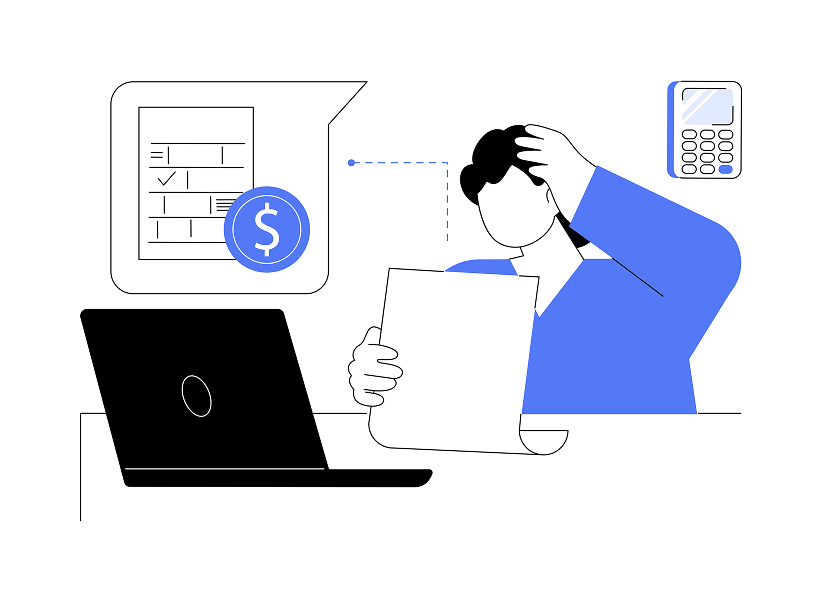
Imagine you receive a client payment of €1,200, and it includes VAT at 20%. You want to know how much of that is VAT and how much is actual income.
Using the calculator:
- Select “Amount includes VAT”
- Enter €1,200
- Choose 20% VAT
The calculator reveals that €1,000 is your net income, and €200 is VAT to be reported.
Example of charging VAT
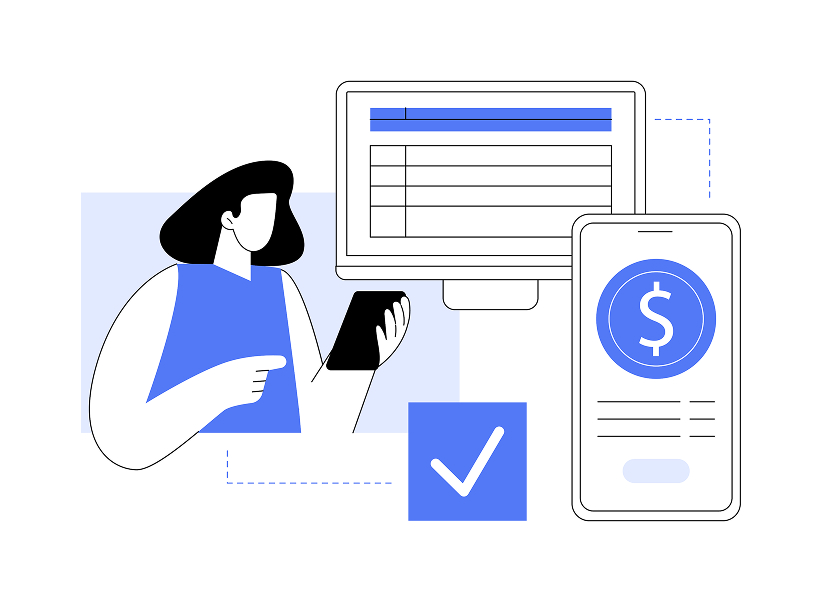
You are issuing an invoice for services worth £2,000, and you need to add VAT at 20%.
Using the calculator:
- Select “Add VAT”
- Enter £2,000
- Choose 20% VAT
The tool will instantly show the VAT as £400, bringing the total invoice amount to £2,400.
How much is the VAT rate?
How much is VAT rate in the UK? 🇬🇧
The standard VAT rate in the UK is 20%, with reduced rates of 5% for certain goods and 0% for essentials like food and children’s clothing.
How much is VAT rate in France? 🇫🇷
France applies a standard VAT rate of 20%, with reduced rates of 10%, 5.5%, and 2.1% depending on the product or service.
How much is VAT rate in Italy? 🇮🇹
Italy’s standard VAT rate is 22%, with reduced rates of 10%, 5%, and 4% for specific categories like food, medicine, and publishing.
How much is VAT rate in the US? 🇺🇸
The United States does not have a national VAT system. Instead, it uses sales tax, which varies by state and municipality. Rates typically range from 4% to 10%, depending on the location.
How much is VAT rate in Germany? 🇩🇪
Germany has a standard VAT rate of 19% and a reduced rate of 7% for essential items such as food, books, and medical supplies.
How much is VAT rate in Spain? 🇪🇸
Spain’s standard VAT rate is 21%, with reduced rates of 10% and 4% for items such as food, transport, and medicine.
Who needs to pay VAT?
Generally, businesses and individuals who sell goods or services in VAT-registered countries need to charge and collect VAT. If your annual revenue exceeds the local VAT registration threshold, you are required by law to register, collect, and remit VAT.
Consumers technically “pay” VAT, but it is the business’s responsibility to handle the collection and payment to tax authorities. VAT also applies to imports, digital services, and cross-border B2B and B2C transactions.
What determines VAT rates?
Several factors determine how VAT is applied to a transaction, including the type of goods or services, the seller’s location, the buyer’s location, and the status of the client.
Type of product
Several factors determine how VAT is applied to a transaction, including the type of goods or services, the seller’s location, the buyer’s location, and the status of the client.
Seller location
The country where the seller is based typically determines whether VAT must be applied.
Sellers operating in VAT-registered countries must adhere to their local rules and rates.
Buyer location
VAT may vary depending on whether the buyer is in the same country, another EU country, or outside the EU.
For B2B cross-border sales in the EU, the reverse charge mechanism may apply, where the buyer handles VAT instead of the seller.
Client status
Whether your client is a business or an individual also affects VAT.
B2B transactions are often exempt from VAT if both parties are registered, while B2C sales usually require VAT to be charged.
Benefits of using a VAT calculator
Using Invoice Fly’s Online VAT calculator ensures speed, accuracy, and compliance. Instead of manually applying percentages or using spreadsheets, the calculator instantly provides the correct VAT allocation or addition based on your inputs. It helps prevent tax errors, simplifies invoicing, and saves time—especially when dealing with international clients or multiple VAT rates.
Here are the key benefits of using our free VAT calculator:
Instant calculations
Get accurate VAT amounts in seconds, whether you’re adding or allocating VAT.
No manual math
Eliminate errors from spreadsheets and manual formulas.
Supports global VAT rates
Calculate VAT for countries like the UK, France, Germany, Spain, and more.
Easy for freelancers & SMEs
Perfect for self-employed professionals and small businesses who invoice frequently.
Customizable inputs
Perfect for self-employed professionals and small businesses who invoice frequently.
With Invoice Fly, you can handle complex VAT scenarios with confidence and simplicity — all from a clean, intuitive interface that works on desktop or mobile.
FAQs about online VAT calculator
VAT and Sales Tax both serve the purpose of taxing consumption, but they function differently.
Sales tax is charged only at the point of sale to the end consumer.
VAT (Value-Added Tax), on the other hand, is applied at every stage of the supply chain—from production to final sale—with each business in the chain reclaiming the VAT they paid.
VAT is common in Europe and many other regions, while the U.S. primarily uses a sales tax system.
VAT is legally charged to the buyer, but the seller is responsible for collecting and remitting it to the tax authorities.
If you’re a business selling to end consumers, you must add VAT to your invoices and pay that VAT to your country’s tax agency.
In B2B transactions, the buyer may be able to reclaim the VAT, especially if the transaction involves the reverse charge mechanism in international trade.
Yes, businesses can usually claim VAT back on eligible business expenses.
If you’re VAT-registered, you can deduct the VAT you’ve paid on purchases (input VAT) from the VAT you’ve collected from sales (output VAT).
The difference is paid to or reclaimed from the government.
Tourists may also be eligible for a VAT refund on goods purchased in some countries, provided they follow the necessary procedures at the border.
Avoiding VAT legally depends on your status and the nature of the transaction. For example:
- If you're a VAT-registered business, you may be able to reclaim VAT on qualifying purchases.
- Some goods and services are zero-rated or exempt, depending on the country and category.
- B2B international transactions within the EU may qualify for the reverse charge mechanism, shifting the VAT responsibility to the buyer.
However, deliberately avoiding VAT unlawfully is considered tax evasion, which has legal consequences. Always follow the tax regulations of your jurisdiction.
Yes, VAT is a form of indirect tax.
It is collected by businesses on behalf of the government and is included in the price of most goods and services in VAT-registered countries.
Although it's not paid directly to the government by consumers, it's still classified as a consumption tax and contributes to national tax revenues.
Some countries apply very low or zero VAT rates on specific goods and services.
Globally, countries like Switzerland (7.7%), Canada (5% GST + provincial taxes), and Japan (10%) have comparatively lower VAT or sales tax rates.
Additionally, several Middle Eastern countries like the UAE have VAT rates as low as 5%, introduced only recently.
Some tax havens, like the Cayman Islands or Hong Kong, have no VAT at all.
As of 2024, Hungary has the highest standard VAT rate in the world at 27%.
Other countries with high VAT rates include Sweden, Denmark, and Norway, all with rates around 25%.
These high VAT rates are often used to support expansive public services like healthcare, education, and social welfare.
Other Free Calculators
Other Free Resources

Try Invoice Fly Today
- Send quotes & invoices in seconds
- Collect card & online payments
- Receive instant notifications
- Win more jobs
